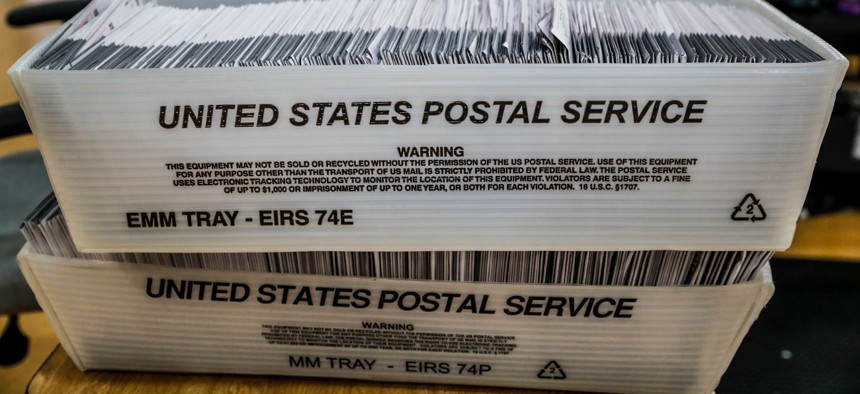
Postal officials do not expect things to get better quickly. Robert Gauthier/Los Angeles Times via Getty Images
DeJoy Predicts USPS Will Miss Its Goal to Break Even Next Year
The Postal Service saw a relief from legislative reforms and price increases in 2022, but still experienced a "controllable" loss due to ongoing volume declines.
The U.S. Postal Service saw its controllable losses increase by $2 billion in fiscal 2022 compared to the prior year, leaving it nearly $500 million in the red as inflationary pressures outweighed its boosted revenue.
When calculating all the items on the agency’s balance sheets, including those management considers outside of its control, USPS saw a new profit of $56 billion due to the one-time cash relief from the changes in the Postal Service Reform Act. The Postal Service saw its revenue jump by nearly 2% even as mail and package volumes both continued to slide due to the high price increases it has instituted.
Postal officials do not expect things to get better quickly. Roman Martinez, chair of USPS board of governors, said at a meeting on Thursday the agency faces “definite headwinds” and Postmaster General Louis DeJoy conceded he will not meet his goal of breaking even by fiscal 2023. Instead, the agency forecasted a more than $4 billion loss next year. While anticipated revenue will grow due to ongoing price hikes, already scheduled cost-of-living adjustments and transportation hikes will continue to be driven upward by inflation.
That outlook could improve if the agency receives additional relief in its retirement costs, this time in how its contributions to the federal employee pension fund are calculated. Postal management has for a decade bemoaned that it is paying more than it owes and said the Biden administration can save it nearly $3 billion next year through an administrative fix.
In the meantime, USPS is moving forward with many of DeJoy’s reforms to the postal network. Those changes, coupled with better equipment, new hiring and the conversions of 100,000 part-time staffers into career employees, has required USPS to hire just 20,000 temporary personnel for the upcoming peak holiday season. That is just half the total the Postal Service hired last year.
“Over the last two years we have stabilized our operations, evolved our products, improved our service, strengthened our balance sheet, halved our projected losses and motivated our employees to join us in this transformation,” DeJoy said on Thursday.
President Biden’s nominees now make up a majority of the Postal Service’s nine appointed board members. The polarizing postmaster general faced little pushback at the board meeting and his fiscal 2023 financial plan won unanimous approval. DeJoy once again called on stakeholders not to resist his plans, saying he can implement his vision within five years if they comply.
“While we are committed to our public service mission, we must move at the speed of private industry, if not faster, to effect this transformation before we again begin to drain our cash position,” the postmaster general said. The Postal Service ended the year with $20 billion in cash on hand, enough to carry it over for about four months.
USPS made significant improvements in its performance in fiscal 2022, though it is operating within slower delivery windows than were in place when DeJoy took office. Overall, USPS delivered 93% of regular, First-Class mail on time, still short of its 95% target but an improvement of the 88.5% rate it hit last year. The farthest traveling mail saw the largest upgrade, with USPS delivering 93% of three-to-five day mail on time this year compared to 86% in fiscal 2021.
Correction: This story has been updated to note the fiscal 2023 financial plan was approved unanimously.







